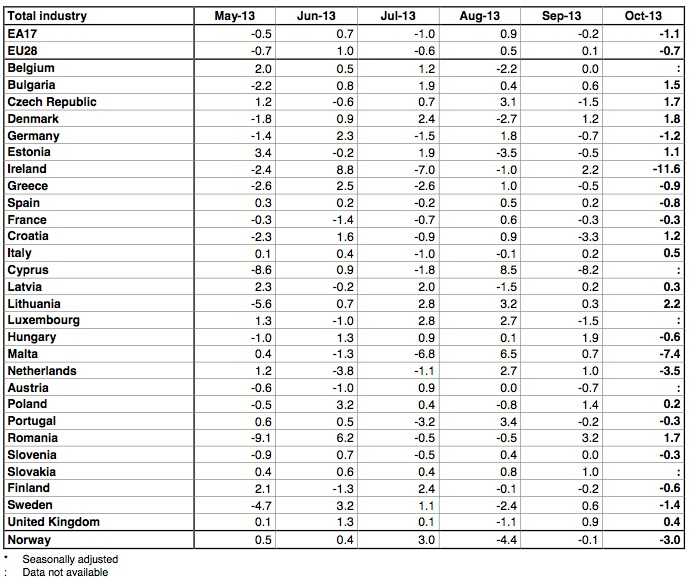European industrial production in October fell 1.1% in the Eurozone and 0.7% in the EU28 (whole European Union consisting of 28 Member States) compared to the previous month, according to new figures published by Eurostat, the EU’s statistical office.
In September industrial production dropped by 0.2% in the Eurozone and grew by 0.1% in the EU28.
Eurostat’s figures surprised most experts, who had expected to see small but progressive signs of a return to moderate growth in the Eurozone, and not the worst results since the height of the crisis.
Compared to October of 2012, European industrial production grew by 0.2% in the Eurozone and 0.8% in the EU28.
European industrial production – monthly comparison
Below is a list of October 2013 production compared to September 2013 in different sectors:
Eurozone
- Energy – (decline) -4%
- Durable goods – (decline) -2.4%
- Capital goods – (decline) 1.3%
- Non-durable consumer goods – (decline) -0.9%
- Intermediate goods – (growth) +0.4%.
EU28
- Energy – (decline) -2.7%
- Durable goods – (decline) -1.5%
- Capital goods – (decline) 0.9%
- Non-durable consumer goods – (decline) -0.8%
- Intermediate goods – (growth) +0.5%.
European industrial production fall “is nasty”
In Europe’s largest economy, Germany, industrial production fell by 1.2% in October, while in the Eurozone’s second largest economy, France, production fell by 0.3% for the second consecutive month.
Great Britain, which is a EU28 member but not in the Eurozone, industrial production increased by 0.4% in October.
Despite the fact that industrial production was dragged down by a sharp fall in energy output, “the 1.1pc drop in eurozone industrial production in October is nasty. October’s marked drop in industrial production indicates that the Eurozone is struggling to regain even modest economic momentum,” Howard Archer, chief European economist for IHS Global Insight told the Telegraph.
In an interview with the Financial Times, Ben May, European economic at Capital Economics, said: “October’s data suggest that industry may well act as a drag on GDP growth in the fourth quarter. Production would have to expand by 0.9 per cent in November and December just for the sector to stagnate.”
Martin van Vliet, an economist at ING, said to Reuters: “All in all, today’s industrial production figures clearly highlight the bumpy and fragile nature of the euro zone’s economic recovery.”
European industrial production excluding construction (compared to previous month):
(Source: Eurostat)

